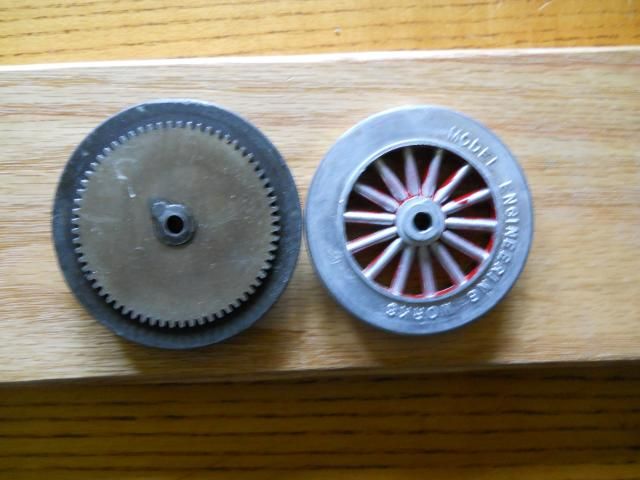I just got these wheels from Harry Henning to replace the old wheels on my AF Shasta I'm restoring. Right off the bat they seem under sized and do I need to take the gear off and put it on the new wheel? What am I doing wrong?

|




|
I just got these wheels from Harry Henning to replace the old wheels on my AF Shasta I'm restoring. Right off the bat they seem under sized and do I need to take the gear off and put it on the new wheel? What am I doing wrong?

Replies sorted oldest to newest
I helped get you into this, but I'm not sure I can get you out!
My Shasta has the larger wheels as you show, but they have a different gear boss. They measure 2.165" over the tread (not the flange). But they are unmarked replacement wheels and have the boss for steam engine side rods. There are also indications that the motor has had another set of threaded mounting holes added so the oversize wheels would make it sit at the correct height - but it is still a 1/4" too high.
Both the original and MEW replacement wheels I have measure 1.970" over the tread. They have the same gear boss as on your MEW wheel. My original AF steam wheels measure 2.175"+/-.
The gear diameter on all my original engines - steam or electric and including the Shasta - is about 2.060". Your gear appears to be the correct diameter - slightly more than the MEW tread diameter.
Pictures of the 4637 Shasta in the Greenberg AF Wide Gauge book, pp 28, 29, show it to have smallish appearing wheels that are the same size as smaller electric engines.
Without the engine in hand, I would tend to say the MEW wheels are correct. Why you have much larger original wheels beats me - perhaps it is a steam wheel?
Like I said - may not be much help.
Chris, you will need to take the gear off and put it on the new wheel. They are pressed on and can usually be eased off by prying gently all around with a flat-bladed screwdriver.
That new wheel is not a gear wheel though. An electric locomotive will need two wheels that take gears, and two that do not. The ones that take the gears have an off-center boss that the gear lug fits into so the gear will not slip. George Tebolt sells wide gauge Flyer wheels as:
"Electric Drive Wheel – red spoked (plain or gear side) 8.00"
you specify plain or for gear. If you are re-wheeling a loco you would need to order two of each.
I think that new wheel in your photo is too small for that gear, for Flyer wide gauge. The gear looks to be the same diameter as the flange of the new wheel, which is not right.
Chris,
I've replaced many of these. You should have no real problem getting the gear off by following hojack's advice or filing or grinding the boss holding the gear if it doesn't just pry off. When replacing the gear, make sure that it will seat flush on the boss and use a file if necessary to remove any flash that might interfere. Use about a 1/8" flat punch to secure the gear being careful to strike with the punch on the edges of the gear boss and not too close to the axle hole, so as not to reduce the axle hole size. Do not attempt to just glue the gear in place. If your axles are heavily splined, you may not be able to remove them readily and instead you may have to install the wheels with the axles still spanning the motor, rather than starting with them out. A small arbor press is best used to press the axles into the wheels and an extra set of hands is always welcome so that you can guide the axles straight into the wheels. The Flyer motors that I've dealt with have the extra set of frame mounting screw holes to allow the frame to be mounted at the preferred height on a given locomotive. If you have any further questions, feel free to email me or arrange to call and I'll walk you through the process.
Eric Hofberg
TCA, LCCA
I think I got it guy's. I did grind the boss off both wheels and very gently pried off the gears. I have a hand press I have maybe used three times in about six years I've had it but boy did it come in handy tonight! I pressed both gears on and gave a little press on the boss to give it a slight flange. I measured and made up a quick wheel gauge then pressed the new wheels on checking the gauge. I greased up the gears and I didn't notice any wobble so it seems good!
Thanks for all the input guy's it was a big help! ![]()
Glad it worked out for you! As they say - nothing to it if you know how!
If you don't mind, let us have a peak at the engine after you get it all spruced up.
Chris, here is a good 2-part article on restoring Flyer wide gauge electrics, taking them apart and getting them back together:
It is about the 4635 (Lone Scout engine) which is a little smaller than the Shasta, but everything in the article still applies. I found it helpful.
Access to this requires an OGR Forum Supporting Membership
